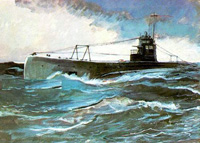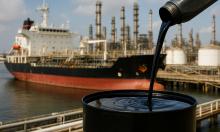USSR’s sunken Komsomolets submarine may turn into underwater Chernobyl
The most advanced nuclear submarine in the world, the Komsomolets, sank in the neutral waters of the Norwegian Sea 20 years ago. The sub had a nuclear reactor and nuclear warheads on board. They can become the source of a massive radioactive pollution at any moment.

USSR’s then-Defense Minister Dmitry Yazov said that the fire broke out in the seventh compartment of the submarine. The crew were trying to extinguish the fire for several hours although to no avail. The submarine sank. A Soviet battleship arrived at the site of the tragedy in three hours, several other vessels followed later. Many of the crew died.
The governmental committee, in which leading specialists were members, could only guess the real reasons of the tragedy. Research vessel Mstislav Keldysh arrived to the site to find the submarine on the seafloor with the help of deepwater submersibles.
Professor Igor Mikhaltsev said that Keldysh had to explore a vast area of the sea bottom. Three specialists went on board the Mir-1 deepwater submersible: they spent eleven hours under the water but did not find the submarine.
Three other specialists boarded the Mir-2 vessel later and came across the Komsomolets by accident. The sub went 2.5 meters deep into the ooze. The damage could be visible on the front part of the hull. The propellers and the aft end were left intact. The pilots found a lifesaving capsule resting some 100 meters far from the submarine. Its upper hitch was open.
The fire on board the Komsomolets occurred on April 7, 1989, at 11:03, at the depth of 386 meters. The sub surfaced, but the fire was becoming stronger. The temperature and the pressure increased sharply. The crew could do nothing when water started filling the submarine. It sank very quickly.
A conclusion from the governmental committee said that the fire broke out on board because of malfunctions in the electric equipment of the pump control system. The sub was equipped with the electric equipment of the 1970s. In addition, a lot of combustible materials were used during the construction and the finishing of the submarine.
The crew hurled all efforts into saving the submarine immediately after the fire was detected on board. When the submariners realized that their vessel was doomed, they struggled to save their own lives. However, they missed the moment. One of the lifesaving vessels was left unengaged. The crew put gas masks on when the concentration of carbon monoxide in the compartments increased. However, the masks melted because of the high temperature.
There were no heated diving suits on board the sub – the suits would have allowed the men to stay in ice-cold water for hours. No one could ever think that the submarine would sink.
Vice Admiral Tengiz Borisovsaidthatthe Soviet government decided to raise the submarine after it had been found with no outward significant damage. Norway originally asked not to do anything with the sunken vessel but then said it should be retrieved. The 5,000-ton, 112-long sub was resting at the depth of 1,685 meters.
Only the USA had the experience of raising a sunken Soviet submarine, although it was much smaller. It sank in shallow waters, but the hull split into two as they were trying to raise it.
The most reasonable project to raise the Komsomolets came from a Dutch firm. They offered to raise the sub with the help of a special crane. The sub was supposed to be raised and put inside a waterlogged floating dock which would then be transported to a base. The operation was evaluated at billions of dollars. The Soviet Union was also supposed to purchase the Dutch equipment if it had been exposed to radiation during the process.
The most unusual plan was supposed to make the Komsomolets become a gigantic iceberg. All the plans became useless when it became known that the submarine had suffered considerable damage.
Two nuclear warheads sank with 20 conventional torpedoes. There was deadly fuel left inside the nuclear reactor too. The fishing industry will have to forget the area for at least 700 years in case of plutonium 239 leak. This substance will become safe only in 200,000 years.
The governments of foreign countries said that the sub could become the source of radioactive pollution. However, the Soviet government stated that the sub was made of corrosion-proof titanium. However, it is titanium that can pose the biggest danger in this case. Other more active metals and alloys, the content of which in the submarine is high, will decompose quickly because of the electrochemical corrosion. Therefore, the Komsomolets disaster can become another Chernobyl.
US and Norwegian specialists found traces of radioactive pollution of the site where the submarine sank. Russia’s special mission to the bottom of the Sea of Norway confirmed the concerns.
A long crack was found on the hull of the sub. The front part of the sub detached itself and was linked to the hull through the kneel-track cribbing. The images, which were transmitted from the bottom of the sea, showed that the torpedo launching gear with nuclear warheads had been smashed with explosions and fire. Weapon grade plutonium leaked into the sea.
Afterwards, Russian specialists conducted a unique operation at the depth of 1,685 meters. Ten cover plugs were installed on the hull of the Komsomolets. Torpedo shutters were covered with titanium plates. The measures were taken in May 1993, but the protection means will last for 20-25 years. For the time being, there are no traces of plutonium in the water.
Izvestia
Subscribe to Pravda.Ru Telegram channel, Facebook, RSS!





